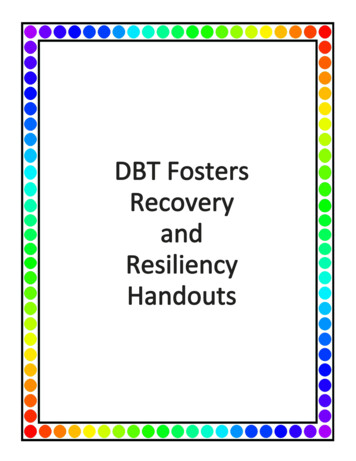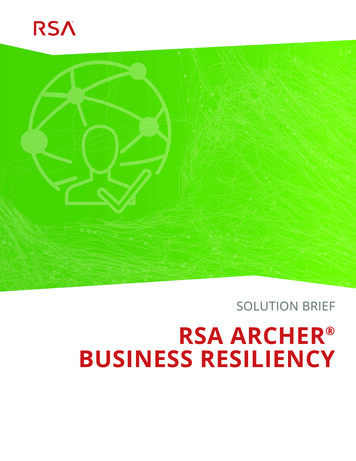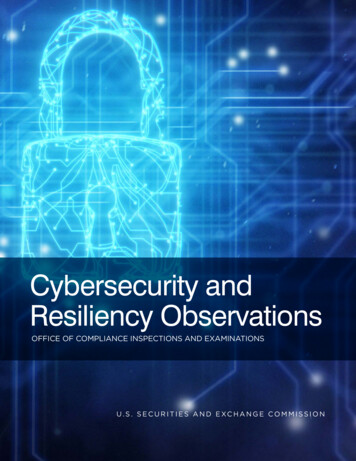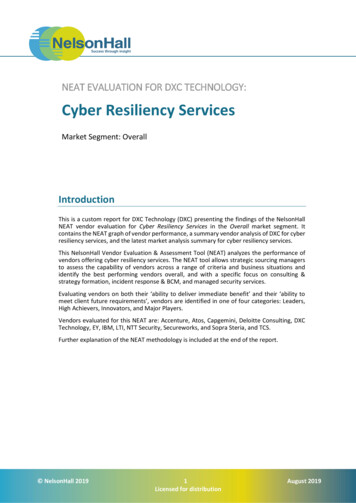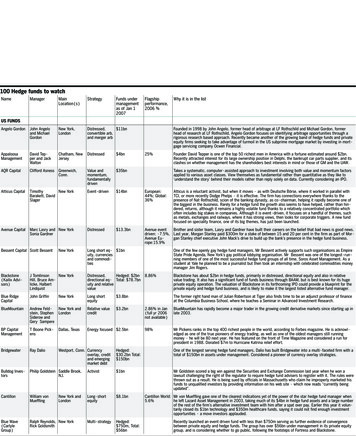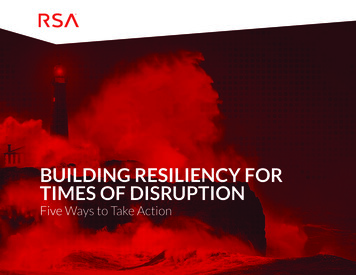
Transcription
BUILDING RESILIENCY FORTIMES OF DISRUPTIONFive Ways to Take ActionBUILDING RESILIENCY FOR TIMES OF DISRUPTION: FIVE WAYS TO TAKE ACTION 1
Business disruptions can catch us off guard. In a time ofcrisis, many organizations may not be entirely sure how torespond. After all, global and prolonged disruptions don’tcome along every day. And when they do, they rarely havethe profound personal and global implications we’ve seenin 2020. But whatever the nature of the disruption, it’s“The time for action is now.It’s never too late to dosomething.”Antoine de Saint-Exupérynever too late to take action. Here are five steps you cantake to reduce the impacts on your organization, people,customers and business objectives.BUILDING RESILIENCY FOR TIMES OF DISRUPTION: FIVE WAYS TO TAKE ACTION 2
STEP 1:IMPLEMENTRESPONSE ANDRECOVERYPLANSNow, more than ever, is the time to have response and recovery plans that enable yourorganization to react, adapt and recover from disruption. Response and recovery plansshould be designed to:Protect your people and enable them to do their jobs and support recoveryof the businessMaintain (and recover, if needed) critical functions and supporting systems,locations and dataEnsure critical third parties are providing the level of service your organizationneeds, or make alternative plans if possibleCase in Point: CDC Resources for Pandemic PlanningIf you don’t have response and recovery plans for large-scale disruptions such asa pandemic, take a look at this pandemic planning template from the Centersfor Disease Control and Prevention (CDC). You can input this content into theRSA Archer Business Continuity & IT Disaster Recovery Planning use case, adapt the plans and activities to your organization’s situation, and begin tomanage your response and recovery right away.BUILDING RESILIENCY FOR TIMES OF DISRUPTION: FIVE WAYS TO TAKE ACTION 3
STEP 2:EFFECTIVELYMANAGE THECRISIS EVENTCrisis response teams are responsible for leading their organizations successfully through businessdisruptions – quickly making response decisions, enabling the organization to take appropriateaction, communicating efficiently and coordinating with business recovery teams. It’s vital to keepthe organization and extended ecosystem informed and acting in lockstep with each other. Followthese guidelines to help ensure effective crisis management:Use technology with a standards-based and best-practices approach tocoordinate activities, so crisis teams can focus on actions requiring theirexpertise and judgmentQuickly establish the crisis team and executive leadership as a source oftruth and guidanceUse communication methods that make information easy to consume (such asmobile devices) and that support real-time back-and-forth messaging betweenresiliency leaders and response and recovery teamsProvide leadership with real-time status updates so they can communicate timelyinformation to the larger community“For every 10% that a team outscored other teams on virtual communicationeffectiveness, they also outscored those teams by 13% on overallperformance.”“Five Ways to Improve Communication in Virtual Teams,” MIT Sloan Management Review1BUILDING RESILIENCY FOR TIMES OF DISRUPTION: FIVE WAYS TO TAKE ACTION 4
STEP 3:EMPOWERYOUR DYNAMICWORKFORCEDisruptions can necessitate that your workforce work remotely, potentially creating stress foremployees, contractors and others who are not accustomed to working from home. Remote workcan also create security risks if they are using their own devices to log in or using corporate laptopsat home where they’re not likely to have the security protocols required in the office. As you workto balance empowering your dynamic workforce to work independently with keeping your onlineresources secure, there are several things you can do to smooth the transition:Develop straightforward, concise work-from-home policies and proceduresRamp up help desk operations and ensure procedures includework-from-home supportEnsure you have adequate secure access and authentication technologiesand controls in placeSupport mental and emotional well-being with an employee assistance programor wellness program45% of professionals who handle confidential data at work admitted tousing public Wi-Fi and personal email to do so.Dell End-User Security Survey2BUILDING RESILIENCY FOR TIMES OF DISRUPTION: FIVE WAYS TO TAKE ACTION 5
STEP 4:DRIVERESILIENCYACROSS YOURTHIRD PARTIESThird parties are partners, vendors, contractors and supply chains your organization engagesto achieve your strategic objectives. Your third parties become an integral extension of yourorganization and enable you to support customers, innovate, implement technologies and more.However, disruptions that impact your organization may affect your third parties’ ability toperform, and vice versa. It’s a symbiotic relationship that carries risk, so it’s important to buildresiliency across your broader business ecosystem. In the midst of a business disruption, itis critical to:Work with your third-party risk teams to understand the continuity status ofyour most critical third partiesUnderstand supply chain exposures, prioritize them and address gaps assoon as possibleCoordinate your response and recovery plans with those of your mostcritical third partiesAutomate and orchestrate policies across data security tools, and adapt rulesand controls based on changing workforce needs and observed behaviors70% of risk management professionals characterize their organization asmoderately to highly dependent on external entities.“Reestablishing the perimeter: Extending the risk management ecosystem,” DeLoitte3BUILDING RESILIENCY FOR TIMES OF DISRUPTION: FIVE WAYS TO TAKE ACTION 6
STEP 5:DON’T FORGETOTHER RISKSDuring disruptions, other risks your organization is dealing with don’t stop. In fact, they may evenescalate as bad actors try to take advantage through cyber attacks or fraud. Regulatory compliancecan receive less attention as teams change their focus to current business impacts. Disruptionsdemand everyone’s attention, and if they extend over a long period of time, the risk of not achievingbusiness objectives can create strategic risk.It is critical to ensure your risk management program enables you to continue to identify newrisks, evaluate and measure critical risks, take appropriate steps to manage the risks withinacceptable tolerance levels, and advise executives on decisions they need to make.Planning for the Next TimeWhen the disruption ends – as disruptions always do – that’s the ideal time to evaluate yourorganization’s response. This should include: Assessment of the effectiveness of response and recovery plans,third-party engagements and contracts and service agreements A look at how your workforce responded, using performance measures,employee turnover statistics and other metrics Evaluation of overall resiliency capabilitiesConsider engaging experts who have helped many other organizations mature their resiliencycapabilities. Now is the time to act, and RSA stands ready to support your organization.BUILDING RESILIENCY FOR TIMES OF DISRUPTION: FIVE WAYS TO TAKE ACTION 7
RSA HELPS YOU COORDINATE BUSINESS RESILIENCYWhile other vendors focus on disaster recovery, RSA approaches resiliency for the digital age more strategically by integrating it with yourorganization’s integrated risk management program and by addressing a range of use cases geared toward digital business, with a strong focuson cybersecurity. The RSA solution for business resiliency is designed to help your organization unify disparate teams, understand businessimpact and coordinate activities to build resiliency.HOW WE HELPASSESS BUSINESSRESILIENCYCAPABILITIESSECURE, RISKBASED ACCESS &AUTHENTICATIONBUSINESSRESILIENCYEVOLVED SIEM/ADVANCED THREATDETECTION &RESPONSEOMNI-CHANNELFRAUD PREVENTIONEngagementRisk-Based AuthenticationBusiness ContextSecurity PlatformAssessmentAuthentication AnomalyDetectionCriticality & PriorityLogs & PacketsOmni-Channel FraudDetectionRisk AssessmentEndpointAdvanced AdaptiveAuthenticationRecovery & TestingUEBAReal-Time Risk AssessmentIncident & CrisisOrchestration &AutomationFraud IntelligenceRisk QuantificationGovernanceBenchmark ReportIdentity, Governance &Lifecycle ManagementAccess PolicyViolation DetectionAnti-Phishing ThreatManagementTo see how RSA can help you take action to make your organization more resilient, contact us to request a demoBUILDING RESILIENCY FOR TIMES OF DISRUPTION: FIVE WAYS TO TAKE ACTION 8
DIGITAL RISK IS EVERYONE’S BUSINESSHELPING YOU MANAGE IT IS OURSRSA offers business-driven security solutions that provide organizations with a unifiedapproach to managing digital risk that hinges on integrated visibility, automated insights andcoordinated actions. RSA solutions are designed to effectively detect and respond to advancedattacks; manage user access control; and reduce business risk, fraud and cybercrime. RSAprotects millions of users around the world and helps more than 90 percent of the Fortune500 companies thrive and continuously adapt to transformational change.Find out how to thrive in a dynamic, high-risk digital world at rsa.com1. N. Sharon Hill and Kathryn M. Bartol, “Five Ways to Improve Communication in Virtual Teams,”MIT Sloan Management Review, Fall 2018 Issue2. End User Security Survey 2017, Dell3. “Reestablishing the perimeter: Extending the risk management ecosystem,” Deloitte, October 2018 2020 Dell Inc. or its subsidiaries. All Rights Reserved. RSA and the RSA logo are trademarks of Dell Inc. or its subsidiaries in the UnitedStates and other countries. All other trademarks are the property of their respective owners. RSA believes the information in thisdocument is accurate. The information is subject to change without notice. Published in the USA, 4/20 eBook H18243 W353671
RSA Archer Business Continuity & IT Disaster Recovery Planning use case, adapt the plans and activities to your organization’s situation, and begin to manage your response and recovery right away.

